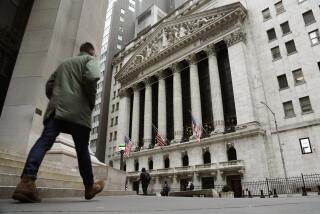Stocks Rally as Oil Prices Fall
- Share via
Oil prices took their biggest one-day tumble since June on Wednesday, helping spark a broad rally on Wall Street.
The government’s weekly report on U.S. crude inventories showed a better-than-expected increase, which raised hopes that improving supplies could halt oil’s dramatic ascent.
The news triggered heavy selling of crude futures in New York, where the contract for December delivery plunged $2.71, or 4.9%, to $52.46 a barrel. It was the largest pullback since prices slid 5.6% on June 2.
And the stock market surged as oil fell, lifting the Dow Jones industrial average 113.55 points, or 1.2%, to 10,002.03.
Including Tuesday’s advance, blue-chip indexes had their best two-day rally since spring 2003. Technology, retailing, airline and healthcare stocks led the advance Wednesday.
The oil market “might be at a turning point here,” said Marshall Steeves, an analyst at commodities brokerage Refco Inc. in New York.
Other analysts, however, said that was far from clear, and some questioned whether the traders selling oil futures Wednesday were misinterpreting the latest supply data.
The nation’s crude inventories climbed 3.9 million barrels to 283.4 million in the week that ended Friday, the Energy Information Administration said. It was the fifth straight weekly gain and was well above analysts’ estimates of 2 million barrels or less.
Oil topped $55 a barrel Friday for the first time, after a run-up of nearly 30% since mid-September. The advance has been driven in part by production cutbacks in the Gulf of Mexico after Hurricane Ivan tore through the region, damaging drilling rigs and pipelines.
Worries about tighter supplies have helped trigger frenzied bidding for heating oil futures and gasoline futures over the last six weeks, leaving motorists griping at pump prices exceeding $2.40 a gallon.
The jump in energy costs also has weighed on Wall Street, casting doubt on the economy’s ability to grow in 2005.
The latest inventory data suggest that oil prices could be poised for a sustained decline, barring new supply disruptions, Steeves said.
Even so, the Energy Information Administration cautioned Wednesday that crude oil inventories have been rising sharply in recent weeks because U.S. refineries still are completing their fall maintenance and are operating well below capacity.
So although crude inventories are growing, supplies of gasoline and heating oil remain limited. In fact, U.S. heating oil inventories fell 2.4 million barrels last week to 116.6 million, the government said.
Overall, global energy supplies remain tight and demand continues to be strong, and that probably precludes a downward trend in prices, said Seth Kleinman, an analyst at PFC Energy, a consulting firm in Washington.
Wednesday’s drop “was just a technical correction” after the steep gains since mid-September, and oil could quickly be back to $55 in coming weeks, he said.
Longer term, however, rising crude supplies mean there will be more inventory available to turn into heating oil and gasoline. That could dim the appetite of speculators who have been helping to power the run-up in energy futures prices simply because the market was hot, analysts said.
Natural gas futures also dived Wednesday. The near-term contract in New York slumped 78 cents, or 9.2%, to $7.63 per million British thermal units.
On Wall Street, the slide in energy prices gave a green light to investors who have been waiting for some good news to justify jumping back into stocks, said Leo Grohowski, chief investment officer at Deutsche Bank in New York.
“I think the market was looking for a reason to rally here,” he said. If oil can stay closer to $50 than $60 in the next few weeks, stocks should continue to advance, he said.
Blue-chip shares had been falling since early October as oil soared. The Dow hit an 11-month low Monday, closing at 9,749.99.
The market began to recover Tuesday, when the Dow jumped 138.49 points. The index is up 2.6% since Monday.
The broader Standard & Poor’s 500 index rose 14.31 points, or 1.3%, to 1,125.40 on Wednesday, after adding 1.5% on Tuesday.
The technology-heavy Nasdaq composite index led the way Wednesday, surging 41.20 points, or 2.1%, to 1,969.99.
Winners outnumbered losers by more than 2 to 1 on Nasdaq and on the New York Stock Exchange. Trading was heavy.
Tech shares have spearheaded the market’s comeback since mid-August, when most broad indexes reached their lows for the year. The Nasdaq index is up 12.4% from its mid-August low, while the Dow is up 2% in the same period, and the S&P; 500 is up 5.8%.
“I think the tech rally is a play on an improving economy next year,” said Kevin Marder, chief market strategist at Ladenburg Thalmann Asset Management in Los Angeles. A continuing economic expansion could encourage more companies to spend money on new tech equipment, he noted.
Many investors, Marder said, are favoring tech now because the shares had been beaten down for much of this year, while other economy-sensitive issues, such as heavy industry companies, had performed well.
Healthcare was another hot sector Wednesday. An index of major drug stocks jumped 2.7%.
That could be a sign that Wall Street expects President Bush to win reelection Tuesday, said Stan Nabi, vice chairman at Silvercrest Asset Management in New York. Many investors believe Bush would be friendlier to healthcare companies than Democratic challenger Sen. John F. Kerry.
More to Read
Inside the business of entertainment
The Wide Shot brings you news, analysis and insights on everything from streaming wars to production — and what it all means for the future.
You may occasionally receive promotional content from the Los Angeles Times.











